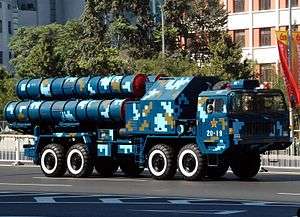Transporter erector launcher

A transporter erector launcher (TEL) is a missile vehicle with an integrated prime mover that can carry, elevate to firing position and launch one or more missiles. Such vehicles exist for both surface-to-air missiles and surface-to-surface missiles. Early such missiles were launched from fixed sites and had to be loaded onto trucks for transport, making them more vulnerable to attack since once they were spotted by the enemy they could not easily be relocated, and if they were it often took hours or even days to prepare them for launch once they reached their new site.
A transporter erector launcher and radar (TELAR) is the same as a TEL but also incorporates part or all of the radar system necessary for firing the surface-to-air missile(s). Such vehicles have the capability of being autonomous, greatly enhancing their effectiveness. With this type of system each vehicle can fight regardless of the state or presence of support vehicles. The TEL or TELAR may have a rotating turntable that it can use to aim the missiles. The vehicle may have to turn to aim the missiles or they may fire straight up.
Conversely, a transporter launcher and radar (TLAR) is the same as a TELAR without the erector capability, because the missile in question is transported in the launch-ready position. An example is the 9K330 Tor, which mounts a Vertical Launching System-style block of SAMs.
Usually a number of TELs and TELARs are linked to one command post vehicle (CP or CPV). They may use target information from Target acquisition, designation and guidance radar (TADAGR) or, simply, TAR.
The Patriot missile system uses the abbreviation MEL (Mobile Erector Launchers) as a towed launch vehicle.[1]
Types
- Taian TA580/TAS5380 8×8 Transporter erector launcher (TEL)
- Wanshan WS-51200 16 wheeled TEL
- M270 Multiple Launch Rocket System
- Pinaka multi barrel rocket launcher
- S-300 TEL with MAZ-7910 8 × 8 wheeled truck or MT-T tracked transporter
- MAZ-547A/MAZ-7916 - 12 wheeled TEL
- MAZ-7917 - 14 wheeled TEL
- MZKT-79221 wheeled TEL
- ASTROS II 6x6 wheeled rocket artillery launcher
- SPYDER
Gallery
 A Russian SA-12 TELAR in transit mode.
A Russian SA-12 TELAR in transit mode. A Russian SA-10 TEL ready for launch.
A Russian SA-10 TEL ready for launch. A French Pluton missile in transit mode.
A French Pluton missile in transit mode..jpg) MZKT-79221.
MZKT-79221. MAZ-7917 TEL.
MAZ-7917 TEL. ZIL-135.
ZIL-135. MLRS.
MLRS. S-300.
S-300.- MAZ7310.
 A German PATRIOT launcher.
A German PATRIOT launcher. Russian Topol-M MZKT-79221.
Russian Topol-M MZKT-79221. HQ-9 portable launcher.
HQ-9 portable launcher.
See also
| Wikimedia Commons has media related to TEL vehicles. |
- Meillerwagen, the earliest-designed mobile rocket erection vehicle (trailer) ever deployed
- Mobile launcher vehicle
- Missile launch facility
References
- ↑ FM 44-94 Army Air and Missile Defense Command Operations. Glossary. Part I – Abbreviations and Acronyms at Federation of American Scientists website